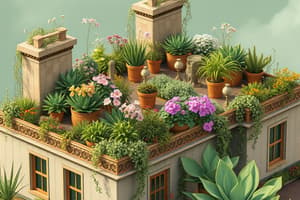Podcast
Questions and Answers
What is the term for all non-living components within a landscape?
What is the term for all non-living components within a landscape?
- Greenscapes
- Hardscapes (correct)
- Softcovers
- Hardcovers
Which element of landscaping adds vibrant colors and fragrant scents to a garden?
Which element of landscaping adds vibrant colors and fragrant scents to a garden?
- Grasses (correct)
- Paving stones
- Furniture
- Sculptures
What is the main focus point in gardens according to the text?
What is the main focus point in gardens according to the text?
- Trees (correct)
- Sculptures
- Fountains
- Groundcovers
Which design aspect aims to create balance, symmetry, texture, and color in a garden?
Which design aspect aims to create balance, symmetry, texture, and color in a garden?
What is an essential consideration in landscape design according to the text?
What is an essential consideration in landscape design according to the text?
What is one way landscape architects can help create healthier ecosystems?
What is one way landscape architects can help create healthier ecosystems?
How can landscape architects reduce pollution risks?
How can landscape architects reduce pollution risks?
What is a key aspect of the integrated design approach in landscape architecture?
What is a key aspect of the integrated design approach in landscape architecture?
What can be achieved by combining expertise from diverse disciplines in landscape architecture?
What can be achieved by combining expertise from diverse disciplines in landscape architecture?
What does landscape gardening aim to merge?
What does landscape gardening aim to merge?
Flashcards are hidden until you start studying
Study Notes
Landscape Gardening is more than just planting flowers and shrubs—it's an art that involves creating harmonious connections between people and nature. It encompasses several key elements that make up this intricate field of design, including hardscapes, softscapes, and environmental considerations.
Hardscapes
The term 'hardscape' refers to all non-living components within the landscape, such as paving stones, retaining walls, fountains, sculptures, and even furniture. These elements play a crucial role in defining the structure and function of a garden space. They serve both functional purposes like drainage regulation and seating areas while also adding visual appeal through interesting textures and shapes. Proper planning and execution of these hardscape features can create balance, symmetry, texture, and color that complements the living aspects of your garden.
Softscapes
Softscapes, on the other hand, refer to the plants, trees, grasses, groundcovers, etc., which bring life to any landscaped area. Plants act as the main focus point in gardens; they add vibrant colors during different seasons, fragrant scents in springtime, and even wildlife habitats if appropriate species are selected. A well-designed softscape aims to blend together various plants with contrasting characteristics so that each one compliments the others, resulting in a visually appealing arrangement.
Environmental Considerations
A good landscape design always considers its ecological impact. This includes using native plants suitable to local conditions, conserving water usage by implementing efficient irrigation systems, controlling erosion potential, reducing waste generation, minimizing pollution risks, promoting biodiversity, managing stormwater runoff effectively, and mitigating extreme weather events. By incorporating green solutions into their designs, landscape architects can help create healthier ecosystems while preserving natural resources.
Integrated Design Approach
Incorporating sustainable practices into landscape architecture requires an integrated approach where multiple specialists work together. This could involve collaboration among professionals from fields such as agriculture, forestry, soil science, hydrology, and engineering. Combining expertise in these diverse disciplines allows for comprehensive problem solving tailored specifically for each site context.
Landscape Gardening truly merges functional considerations with aesthetic beauty. It offers homeowners, businesses, governments, institutions, schools, hospitals, and resorts opportunities to develop healthy relationships with the environments around them. So next time you wander through a beautifully designed park or walkway, remember how much skill went into making those spaces so pleasant —that's the magic of landscape gardening!.
Studying That Suits You
Use AI to generate personalized quizzes and flashcards to suit your learning preferences.




